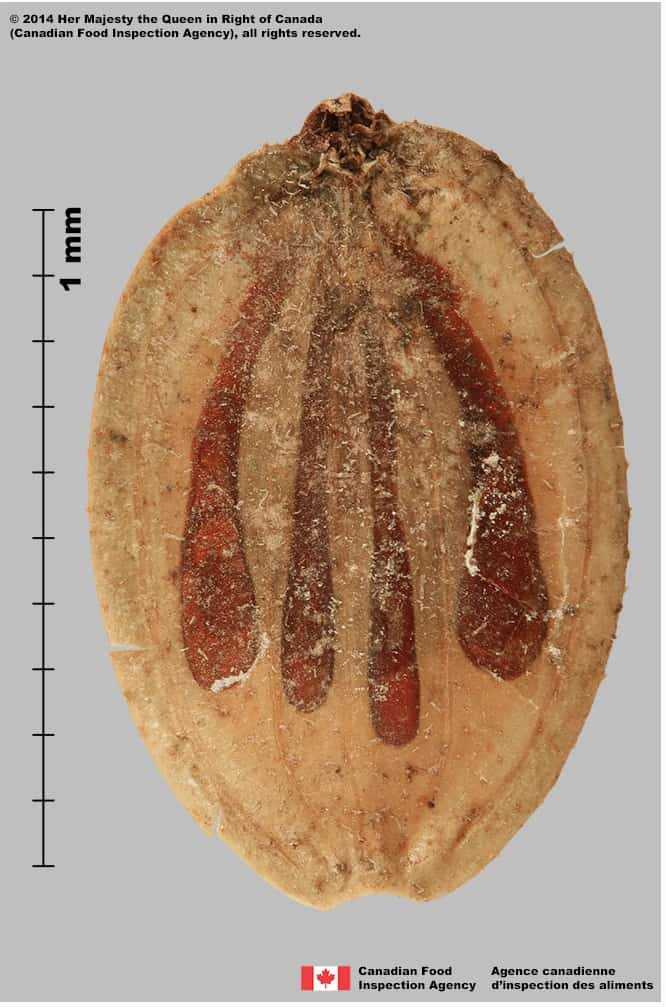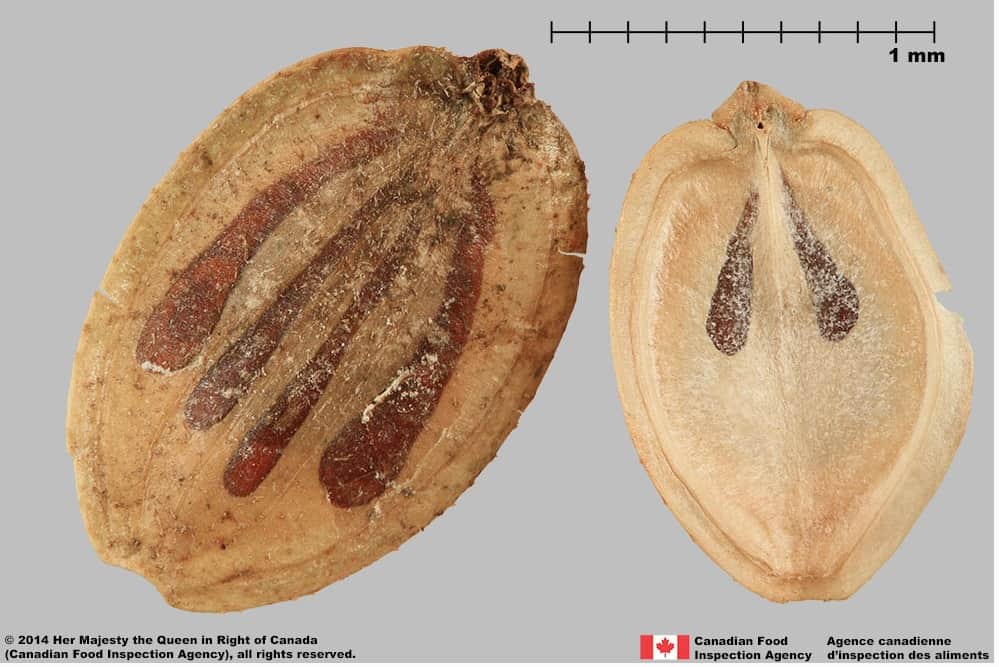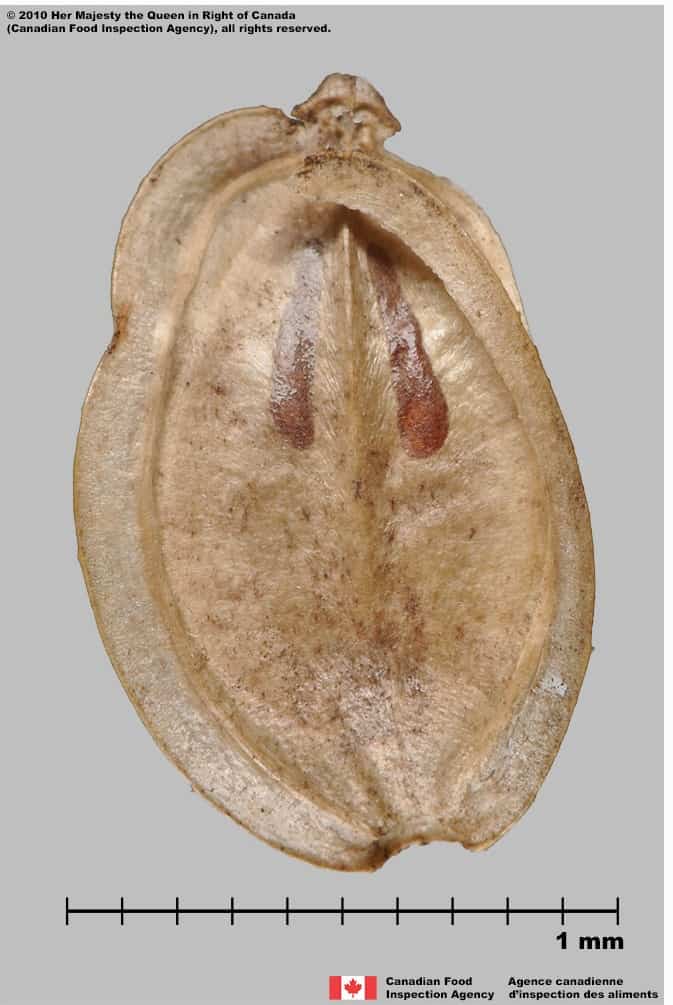Heracleum sosnowskyi
Overview
Aperçu
Regulation :
Remarques Réglementation:
- CFIA Weed Seeds Order - Class 2: Primary Noxious Weed Seeds
Regulation Notes:
Distribution :
Répartition :
The species is native to the Caucasus region of Asia (Azerbaijan, Georgia, Russia) and cultivated in eastern Europe and Korea (USDA-ARS 2022). It is absent from Canada (Brouillet et al. 2010+).
Habitat and Crop Association :
Habitat et Cultures Associées :
Fields, old gardens, farmyards, pastures, meadows, grasslands, bushlands, abandoned orchards, forest edges, parks, river valleys, roadsides, railway lines, and disturbed areas (CABI 2022).
Economic Use, cultivation area, and Weed Association :
Utilisation économique, zone de culture et association de mauvaises herbes :
Duration of Life Cycle :
Durée du cycle vital:
Perennial
Dispersal Unit Type :
Type d’unité de dispersion :
Schizocarp, divided into 2 mericarps
General Information
RENSEIGNEMENTS GÉNÉRAUX
Heracleum sosnowskyi has been cultivated as an ornamental, for fodder, and for honey production (CABI 2022). H. sosnowskyi was planted in Russia and surrounding regions for silage fodder for livestock, but has now spread into surrounding European countries since the 1970s (Stojanović et al. 2017).
H. sosnowskyi plants do not flower until they are two years or older (CABI 2022). Once flowering and subsequent seed production are complete, the plants die (CABI 2022).
Seed dispersal occurs primarily by human activity, via water in flooded areas and by wind in dry areas, 1.0 – 4.0 metres from the parent plant (CABI 2022; Kabuce and Priede 2010; Panasenko 2017). The seeds require bare soil in disturbed or eroded areas to germinate and grow (Panasenko 2017). A single plant can produce approximately 10000-15000 seeds (Panasenko 2017). H. sosnowskyi has been reported to be more shade tolerant than H. mantegazzianum (Kabuce and Priede 2010).
.
Identification
Identification
-
Mericarp
Size
- Mericarp length*: 4.5 – 9.9 mm; width: 3.6 – 97.9 mm
- Mericarp length: 10.7 – 14.4 mm; width: 7.0 – 9.8 mm (Klimko et al. 2013)
*Note: minimum and maximum of 10 mericarps in a normal range of this species using image measurement (ISMA 2020)
Shape
- Mericarp is long oval shaped, egg-shaped or heart-shaped mericarp, flattened and winged around the outside
- One end comes to a point and may be lobed, the other is curved
Surface Texture
- One side of the mericarp has five thin ribs (Jurkonienė et al. 2016), and the other side has two curved ribs that form a circular line
- Several teeth can be generally seen along the edge, especially near the pointed end of the mericarp
- Mericarp may be glabrous or with scattered hairs on one side
- Viewing with a scanning electron microscope, the mericarp’s outer side is ridged reticulate with thick walls between the cells (Klimko et al. 2013)
Colour
- Mericarp is dull or slightly glossy (Klimko et al. 2013) and light yellow coloured
- Brown coloured oil ducts are visible, four on one side (outer side), and two on another side (inner side) (Klimko et al. 2013)
Other Features
Mericarp end with style remnant
- Style remnant is short and triangular shaped
- A piece of connective tissue from between the mericarps may be attached to the style remnant
Other features
- The oil ducts on the outer side begin below the pointed end and generally extend 3/4 down the mericarp and have enlarged ends
- The oil in the fruit and seed can burn and blister skin (CABI 2022)

Hogweed (Heracleum sosnowskyi) mericarps






-
Seed
Size
- Seed length: 6.3 – 6.9 mm; width: 4.2 – 4.8 mm (Klimko et al. 2013)
Shape
- Seed is oval-shaped, flattened
- Oil ducts may remain attached to the seed, or be removed with the fruit wall
Surface Texture
- Seed is smooth
Colour
- Seed is dark grey coloured
Other Features
- Seed coat thin, transparent, adhering to the fruit wall
- A portion of the oil ducts remain fused to the seed when the fruit wall is removed
- The oil in the fruit and seed can burn and blister skin (CABI 2022)
-
Embryo
Size
- Embryo rudimentary size
Shape
- Embryo is linear in shape
Endosperm
- Endosperm is soft and oily, translucent grey coloured
Other Features
- Embryo is in a basal position
Identification Tips
CONSEILS POUR L’IDENTIFICATION
Several genera within the Apiaceae have straw yellow coloured fruits that are flattened with longitudinal reddish oil ducts, e.g. Heracleum, Aethusa, Angelica and Pastinaca. Heracleum sosnowskyi mericarps have a deep notch at the end with the style remnant, teardrop-shaped oil ducts and teeth along the edge of the mericarp. The mericarps of H. mantegazzianum look similar to Heracleum sosnowskyi.

Hogweed (Heracleum sosnowskyi) mericarp, outer side






Additional Botany Information
AUTRES RENSEIGNEMENTS BOTANIQUES
Flowers/Inflorescence
- Flowers have white or pinkish petals (Kabuce and Priede 2010), the style remnant is cap-like and remains on the fruit as the pointed end
Vegetative Features
- Plants may reach a height of 3 metres (CABI 2022)
Similar Species
ESPÈCES SEMBLABLES
Similar species are based on a study of seed morphology of various species, and those with similar dispersal units are identified. The study is limited by physical specimen and literature availability at the time of examination, and possibly impacted by the subjectivity of the authors based on their knowledge and experience. Providing similar species information for seed identification is to make users aware of similarities that could possibly result in misidentification.
Heracleum mantegazzianum Sommier & Levier (giant hogweed)
H. mantegazzianum mericarps are variable and the range may overlap with H. sosnowskyi (length*: 7.3 – 11.5 mm; width: 5.4 – 7.6 mm), other features of H. mantegazzianum mericarps may also be similar to H. sosnowskyi, making them difficult to distinguish. Viewing with a scanning electron microscope, H. mantegazzianum mericarp’s outer side is reticulate (slightly ridged) with thin walls and cells elongated in one plane, while H. sosnowskyi has ridged reticulation with thick cell walls and no elongation (Klimko et al. 2013).
Heracleum sphondylium subsp. montanum Schleich. ex Gaudin) Briq. (cow parsnip)
H. sphondylium subsp. montanum mericarp sizes are variable, and overlap in size (length*: 6.6 – 12.5 mm; width: 4.9 – 8.6 mm) with H. sosnowskyi, but without teeth along the mericarp edge and the oil ducts are more narrow compared to H. sosnowskyi.
*Note: minimum and maximum of 20 mericarps in a normal range of this species using image measurement (ISMA 2020)
Heracleum persicum Desf.
H. persicum is native to Iran, Iraq, and Turkey but is invading countries in Europe, including northern European countries of Denmark, Finland, Iceland, Norway and Sweden (Sachajdakiewicz and Bzdęga 2017; CABI 2022). H. persicum was introduced as an ornamental, but may also be spread by demand for its seeds, which are ground for use as a spice (Asgarpanah et al. 2012; Sachajdakiewicz and Bzdęga 2017; CABI 2022) and for medicinal purposes (Asgarpanah et al. 2012; CABI 2022).
Unlike H. mantegazzianum and H. sosnowskyi, plants of H. persicum are perennial and do not die following seed production and are able to reproduce vegetatively. H. persicum and H. sosnowskyi plants exude an anise-like smell (Kabuce and Priede 2010; CABI 2022) and not the resinous or musty smell of H. mantegazzianum (Page et al. 2006).
Mericarps may overlap in size (length: 7 – 8 mm (Asgarpanah et al. 2012), length: 8 – 14 mm; width: 6 – 9.5 mm (CABI 2022)) with those of H. sosnowskyi. Generally, H. persicum mericarp’s oil glands are only slightly wider at one end (Asgarpanah et al. 2012; CABI 2022) compared to those of H. sosnowskyi that are noticeably swollen at one end.
Click to select species
Cliquez pour sélectionner les espèces

Heracleum mantegazzianum

Heracleum sphondylium subsp. montanum
Comparison Window
Fenêtre de comparaison
MAIN SPECIES
ESPÈCES PRINCIPALES
Heracleum sosnowskyi

Heracleum sosnowskyi
Apiaceae
Hogweed (Heracleum sosnowskyi) mericarps
MAIN SPECIES
ESPÈCES PRINCIPALES
Heracleum sosnowskyi

Heracleum sosnowskyi
Apiaceae
Hogweed (Heracleum sosnowskyi) mericarps
MAIN SPECIES
ESPÈCES PRINCIPALES
Heracleum sosnowskyi

Heracleum sosnowskyi
Apiaceae
Hogweed (Heracleum sosnowskyi) mericarp, outer side
MAIN SPECIES
ESPÈCES PRINCIPALES
Heracleum sosnowskyi

Heracleum sosnowskyi
Apiaceae
Hogweed (Heracleum sosnowskyi) mericarp, inner side
MAIN SPECIES
ESPÈCES PRINCIPALES
Heracleum sosnowskyi

Heracleum sosnowskyi
Apiaceae
Hogweed (Heracleum sosnowskyi) mericarps, inner side (R) and outer side (L)
MAIN SPECIES
ESPÈCES PRINCIPALES
Heracleum sosnowskyi

Heracleum sosnowskyi
Apiaceae
Hogweed (Heracleum sosnowskyi) mericarp, brown oil duct in centre
SIMILAR SPECIES
ESPÈCES SEMBLABLES
Heracleum mantegazzianum

Heracleum mantegazzianum
Apiaceae
Heracleum mantegazzianum (giant hogweed) mericarps
SIMILAR SPECIES
ESPÈCES SEMBLABLES
Heracleum mantegazzianum

Heracleum mantegazzianum
Apiaceae
Heracleum mantegazzianum (giant hogweed) mericarps
SIMILAR SPECIES
ESPÈCES SEMBLABLES
Heracleum mantegazzianum

Heracleum mantegazzianum
Apiaceae
Heracleum mantegazzianum (giant hogweed) mericarp; outer side
SIMILAR SPECIES
ESPÈCES SEMBLABLES
Heracleum mantegazzianum

Heracleum mantegazzianum
Apiaceae
Heracleum mantegazzianum (giant hogweed) mericarp, inner side
SIMILAR SPECIES
ESPÈCES SEMBLABLES
Heracleum mantegazzianum

Heracleum mantegazzianum
Apiaceae
Heracleum mantegazzianum (giant hogweed), teeth along the edge of mericarp, especially near the top of the fruit
Need ID Help?
Besoin d’aide pour l’identification?
Reference(s)
Référence(s)
Asgarpanah J., Dadashzadeh Mehrabani G., Ahmadi M, Ranjbar R. and Safi-Aldin Ardebily M. 2012. Chemistry, pharmacology and medicinal properties of Heracleum persicum Desf. Ex Fischer: A review. Journal of Medicinal Plants Research Vol. 6(10), pp. 1813-1820.
Brouillet, L., Coursol, F., Meades, S. J., Favreau, M., Anions, M., Bélisle, P. and Desmet, P. 2010+. VASCAN, the database of vascular plants of Canada. http://data.canadensys.net/vascan/ Accessed October 31, 2022.
Centre for Agriculture and Bioscience International (CABI). 2022. Invasive Species Compendium, CAB International, Wallingford, UK. https://www.cabidigitallibrary.org/journal/cabicompendium Accessed June 20, 2022.
Global Biodiversity Information Facility (GBIF) Secretariat. 2022. https://doi.org/10.15468/39omei Accessed via https://www.gbif.org/species/3642949 Accessed December 29, 2022.
Government of Canada (GC). 2016. Canadian Weed Seeds Order. https://laws-lois.justice.gc.ca/eng/regulations/SOR-2016-93/page-2.html (English) https://laws-lois.justice.gc.ca/fra/reglements/DORS-2016-93/page-2.html (French)
International Seed Morphology Association (ISMA). 2020. Method for Seed Size Measurement. Version 1.0. ISMA Publication Guide.
Jurkonienė, S., Žalnierius, T., Gavelienė, V., Švegždienė, D., Šiliauskas, L., Skridlaitė, G. 2016. Morphological and anatomical comparison of mericarps from different types umbels of Heracleum sosnowskyi. Botanica Lithuania 22:161-168.
Kabuce, N. and Priede, N. 2010. NOBANIS – Invasive alien species fact sheet – Heracleum sosnowskyi. Online Database of the European Network on Invasive Alien Species – NOBANIS, http://www.nobanis.org/Factsheets.asp Accessed September 3, 2021.
Klimko M., Truchan M., and Wysakowska I., 2013. Fruit and seed morphology of the genus Heracleum L. (Apiaceae) in Poland. Roczniki Akademii Rolniczej w Poznaniu. Botanika – Steciana 17: 13-24.
Panasenco, N.N. 2017. On Certain Issues of Biology and Ecology of Sosnowsky’s Hogweed (Heracleum sosnowskyi Manden). Russian Journal of Biological Invasions 8: 272-281.
Sachajdakiewicz, I. and Bzdęga, K. 2017. Harmonia+PL – procedure of negative impact risk assessment for invasive alien species and potentially invasive alien species in Poland (Appendix A). http://projekty.gdos.gov.pl/files/artykuly/127062/Heracleum-persicum-Barszcz-perski-EN_icon.pdf
Stojanović, V., Petrović, S., Kovačević, J., Stojanović, D. and Bjedov, I. 2017. Heracleum sosnowskyi Manden. (Apiaceae) – a new invasive species in the flora of Serbia. Glasnik Šumarskog Fakulteta, Univerzitet u Beogradu, 116: 215-220.
U.S. Department of Agriculture-Agricultural Research Services (USDA-ARS). Germplasm Resources Information Network – (GRIN), https://npgsweb.ars-grin.gov/gringlobal/taxon/taxonomysimple.aspx Accessed June 20, 2022.



